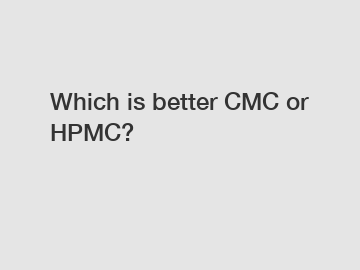Which is better CMC or HPMC?
Which is Better: CMC or HPMC?
In the pharmaceutical and food industries, the use of additives is crucial for various purposes, such as improving viscosity, texture, and stability of products. Two commonly used additives are CMC (carboxymethyl cellulose) and HPMC (hydroxypropyl methylcellulose). Both additives have unique properties that make them suitable for different applications. In this article, we will explore the characteristics of CMC and HPMC and discuss which one is better based on specific criteria.
CMC: An Overview.

CMC, also known as cellulose gum, is a water-soluble polymer derived from cellulose, a natural substance found in plants. It is widely used in the food industry as a thickener, stabilizer, and emulsifier. CMC enhances the viscosity of food products, improves texture, and prevents ingredients from separating due to its excellent water-holding capacity. Moreover, CMC is often used in pharmaceutical formulations as a binder in tablet manufacturing and a film-forming agent in coatings.
HPMC: An Overview.
HPMC, on the other hand, is a semi-synthetic polymer derived from cellulose by modifying its hydroxyl groups. Also water-soluble, HPMC finds applications in various industries. In the construction industry, it is used as a thickener in cement-based products, while in the pharmaceutical industry, it acts as a binder, matrix former in controlled-release systems, and a mucoadhesive agent. Additionally, HPMC is utilized as a film-forming agent, providing protective coatings to oral dosage forms.
Viscosity and Stability.
When it comes to viscosity improvement, CMC and HPMC exhibit different behaviors. CMC generally provides high viscosity even at low concentrations, making it highly efficient in thickening applications. On the other hand, HPMC offers a broader viscosity range, allowing for precise adjustment depending on the desired consistency of the final product.
In terms of stability, both CMC and HPMC contribute significantly. They enhance the stability of emulsions and prevent phase separation in suspensions. Furthermore, their ability to form protective films ensures the stability of pharmaceutical coatings, preventing moisture ingress and maintaining the integrity of the dosage form.
Water Retention and Film-Forming Ability.
One of the primary advantages of CMC is its exceptional water-holding capacity. CMC retains water efficiently, leading to improved moisture retention in food products and preventing them from drying out. This property also makes CMC an excellent choice for use in products prone to freeze-thaw cycles, as it minimizes the formation of ice crystals that can cause product degradation.
In terms of film-forming ability, both CMC and HPMC play crucial roles in the pharmaceutical industry. However, HPMC is known for its stronger film-forming properties due to its higher molecular weight. This makes HPMC films more resistant to mechanical stress and provides better protection to the dosage form.
Which is Better: CMC or HPMC?
Deciding which additive is better, CMC or HPMC, depends on the specific requirements of the application. CMC excels in viscosity improvement, water-holding capacity, and stability enhancement, making it an ideal choice for the food industry. Its excellent film-forming properties also make it suitable for use in pharmaceutical coatings. However, if precise viscosity adjustment and stronger film-forming ability are required, HPMC becomes the preferred option in both the food and pharmaceutical industries.
In conclusion, both CMC and HPMC have unique properties that make them valuable additives in various industries. Each excels in specific characteristics, allowing them to be utilized in different applications. By understanding their differences, one can choose between CMC and HPMC based on the desired outcome. If you have further questions or would like to discuss your specific needs, please feel free to contact us.
(Meta description: CMC or HPMC? Discover the differences between these commonly used additives and determine which one is better based on viscosity, stability, water retention, and film-forming ability.).
Are you interested in learning more about hydroxypropyl methylcellulose powder, hpmc manufacturer, gypsum retarders? Contact us today to secure an expert consultation!

Comments
0